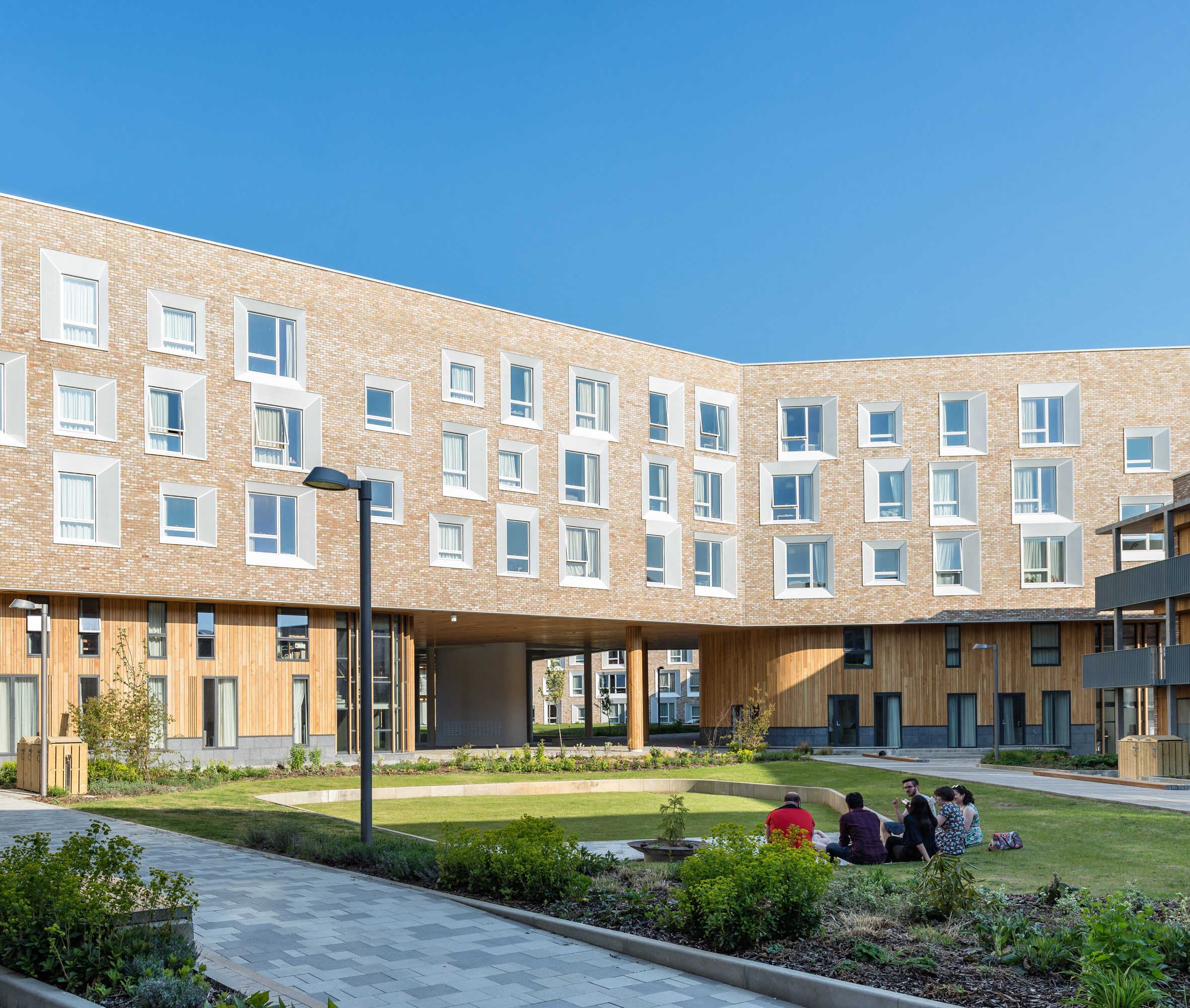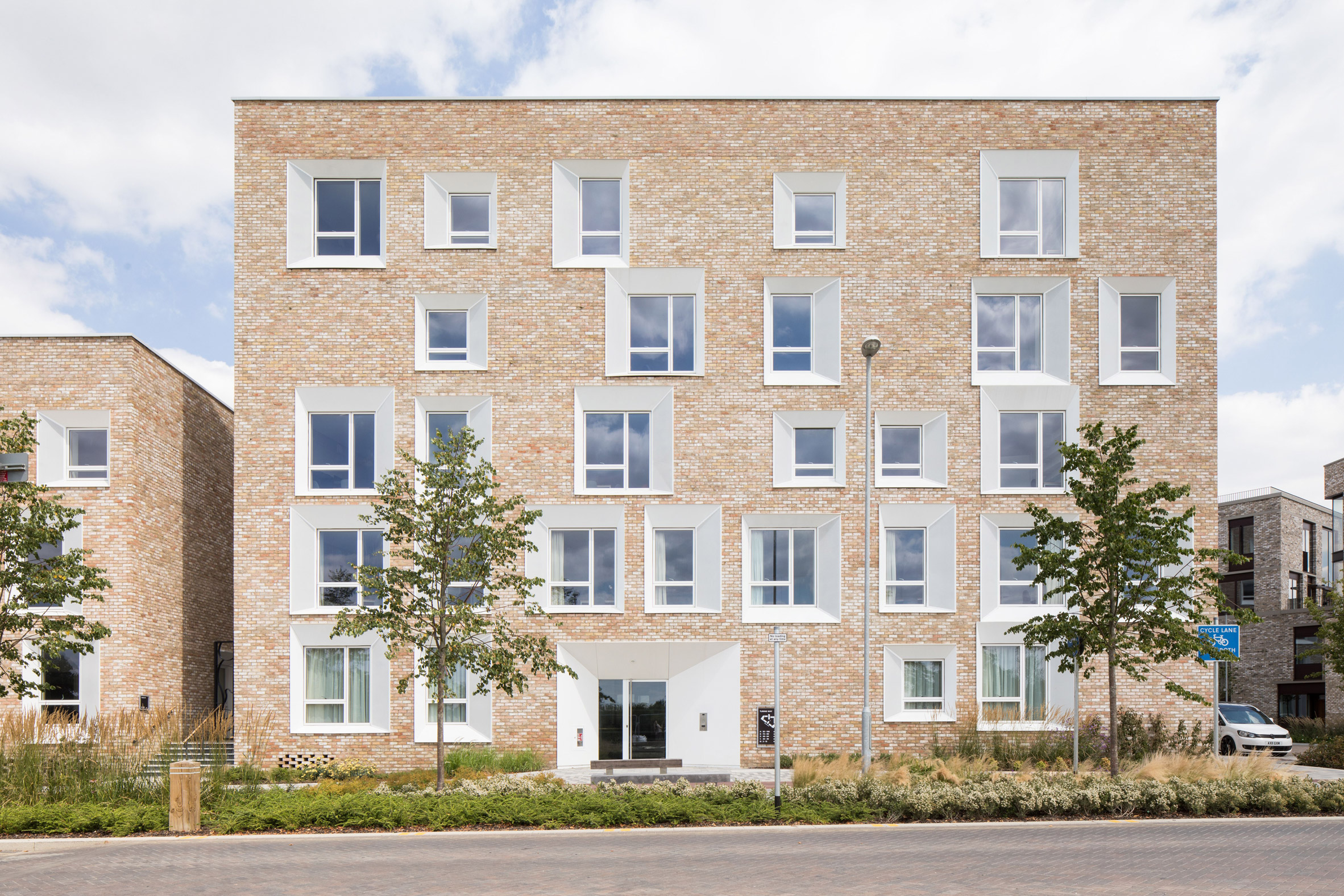
Taken in Argentina, France, Switzerland, Madagascar and Morocco, these photographs speak to the universal message of football.
from It's Nice That https://ift.tt/3ibCeOd

Taken in Argentina, France, Switzerland, Madagascar and Morocco, these photographs speak to the universal message of football.

In the final session of our Nice Hour series, we’ll be sitting down with illustrator Karabo Poppy to advise on how best to work with pattern and colour in varying styles.

Yellow brick walls with unarranged white windows enclose communal courtyards and timber-lined walkways at the heart of Mecanoo's housing for the University of Cambridge.
Located in the city of Cambridge, UK, the Key Worker Housing development contains 232 affordable homes and communal spaces for researchers and key employees at the university.

Key Worker Housing is characterised by its varied material finishes, including oak cladding and yellow bricks, which were chosen by Mecanoo to reflect the "layering of architectural inventions over the centuries" throughout the English city.
Similarly, the housing's layout references the "collegiate character of Cambridge", taking cues from the typical arrangement of the university's colleges that provide accommodation for students and often have a central courtyard.

"Cambridge is a city contextualised through the layering of architectural inventions over the centuries," explained the architecture studio, which is based in Delft.
"This has resulted in a unique composition of urban space, architecture and landscape," it added. "Mecanoo's design adds a new layer to this, building upon the rich traditions and collegiate character of Cambridge."

Inside, the Key Worker Housing contains a mix of different-sized apartments ranging from one bed and two-bed apartments to duplexes with four bedrooms and shared kitchen and study spaces.
These are contained within two blocks that flank a central building, described by Mecanoo as a focal point, which contains communal facilities and divides the scheme into two halves.

The walls around the edge of the complex resemble a protective and monolithic shell, lined with yellow bricks that mimic natural stone walls seen in many buildings around Cambridge.
These are punctured by white windows placed in a "random pattern", which are modelled on local buildings with stone window frames.

Where the buildings face inwards to the courtyards, Mecanoo contrasted the yellow brick finishes with warm oak facades and sheltered areas at ground level, intended as "a modern interpretation of the Cambridge colonnades" and the gates between courtyards in the colleges.
This includes a meandering covered area at the heart of the central building that connects the two courtyards and has been positioned to encourage conversation and interaction between residents.

"The central building creates an opportunity for social encounters and interaction between people that are often from outside the UK living here for the duration of their postdoc," explained Otto Diesfeldt, architect at Mecanoo.
"It separates the two courtyards and connects them via a meandering route below the oak-clad cantilever reminiscent of the gates between courts in colleges," he told Dezeen.

Key Worker Housing is complete with postboxes in the communal area and bike stores at key entrances.
Sustainable building features include photovoltaic cells on the roofs, district heating facilities and a greywater system, while the courtyards feature grass, planters and fruit trees in a bid to encourage biodiversity.

The Key Worker Housing is part of a wider masterplan developed by Aecom for The North West Cambridge Development (NWCD) in response to the lack of affordable city housing in Cambridge for employees of the University of Cambridge.
"University of Cambridge has high demand for affordable key worker housing," said Diesfeldt.
"The size of the university increases while the local housing stock does not," he added. "The increase was high enough to justify that UoC invests in large city expansion on land owned by University of Cambridge."
Alongside housing, the 150-hectare masterplan will also introduce academic facilities, public amenities and open green space.

Mecanoo was founded in the Netherlands in 1984 by Dutch architect Francine Houben, who recently shed light on the studio's founding as part of Virtual Design Festival's collaboration with Architects, not Architecture.
Other recent work by Mecanoo includes a giant red cultural centre in China, a proposal for a copper-coloured tower alongside Frankfurt station and a metal-clad house and cooking school.
Photography is by Mecanoo unless stated.
Project credits:
Architect: Mecanoo
Client: North West Cambridge Development, University of Cambridge
Project management: Aecom
Structural, mechanical and electrical engineer: URS
Acoustic, building physics and fire safety consultant: URS
Cost consultant: Gardiner & Theobald
The post Key Worker Housing by Mecanoo references Cambridge's "architectural inventions over the centuries" appeared first on Dezeen.

Products fair: London designer Adam Nathaniel Furman has created a series of vibrant rugs that take cues from "lazy summer holidays" and ancient Mediterranean ruins.
Designed for London-based rug manufacturer Floor Story, the collection comprises 13 different rugs made of New Zealand wool either hand-woven or made in a tufted style by rugmakers in India.
Each graphic rug was informed by both modern and historic elements of craft and architecture found in Italy and Greece, such as ancient ruins, pottery, sunsets, radial forms of roman mosaics and the shapes seen on the marble pavements in the Pantheon.

"I work hard to make sure that everything I design embodies a kind of voluptuous sensuality, expressed through colour, texture, pattern, form and ornamentation," said Furman.
"The designs are intended to immerse you in history and tradition, but treat both with lightness irreverence and fun," he continued. "This collection brings references and techniques from ancient times and the more recent past, into the present, with joy."

The rug collection includes a rectangular, hand-tufted design called Dipylon, after an ancient Greek vase painter known as the Dipylon Master who was known for adorning funerary vessels with repetitive, geometric motifs.
A series of square rugs coloured in contrasting bright hues called Pantheon also feature, inspired by the marble flooring featured inside the monument, which is patterned with simple circles and squares.
Other pieces in the collection include a circular rug called Armerina – a reference mosaics found in the Piazza Armerina commune in Sicily – and a multi-coloured rectangular rug called Meandros designed as a "simple and bold love letter" to ancient Mediterranean classical decorative motifs.

Furman's Mediterranean collection is just one of a series of rug ranges created for Floor Story by both established and emerging designers, including Camilla Walala and 2LG Studio.
Product: The Mediterranean collection
Designer: Adam Nathaniel Furman
Brand: Floor Story
Contact address: info@floorstory.co.uk
About Dezeen's products fair: the products fair offers an affordable launchpad for new products. For more details email sales@dezeen.com.
The post Adam Nathaniel Furman designs colourful graphic rug collection for Floor Story appeared first on Dezeen.

Architecture studio Morris + Company has designed an extension for the self-built home of Walter Segal in north London that is "a direct homage" to the architect's body of work.
Located in Highgate, London, Segal built North Hill House for himself and his family in 1964.
The London-based architecture studio will renovate and extend the home in a way that aims to respect the work of the original architect, who is best known for developing a system of prefabricated, timber-framed housing in the 1960s and 70s.

"We explored Segal's self build legacy, his approach and ambition, through documentaries in his work, our own site investigations and via texts written by Segal and others on his works," explained Morris + Company founder Joe Morris.
"The scheme has been directly influenced by this research," he told Dezeen. "Whilst it is true that the client will not themselves build their house, the way we envisage its fabrication and assembly is in homage to the self-build principles."

To align with Segal's principles, the extension will be built largely from timber using a series of repeated elements, although it will not use modular construction.
"The project adopts a low specification, dry assembly, prefabrication philosophy as a direct homage to Segal's oeuvre," said Morris.
"Our vision is that the design and detail liberates the build process from excessive site-based activity, without resorting to cost-prohibitive modular construction, which makes little sense for a project of this scale," he continued.
"Instead, readily available, highly sustainable materials – predominantly timber – will be pre-engineered for high-controlled site assembly, without the need for heavy machinery."

Overall, the rear and front extension will double the size of the home, taking it from 166 square metres to 300 square metres.
At the front of the property, the existing access route will be reworked, while a large two-storey rear extension will be built in the garden.
The extensions will form a zigzagged route through the building.

"The original building was economic, simple, elegantly laid out, practical and functional," Morris told Dezeen. "However, much of the fabric of the original was removed and replaced over a sequence of renovations and adaptations."
"Our extension is driven largely by Segal's memory, and indeed the form and composition of the interiors, as a zigzag sequence of interconnected rooms, which has influenced the tectonic composition of the new addition," he continued.

The rear extension, which will be clad in vertical timber battens, will be deliberately offset from the original house so that the rear facade of Segal's home will still be visible from the garden.
"Over time, Segal's own house has been altered, and an adjacent plot infilled obscuring the original from the street," said Morris. "The rear remains largely open but hidden to many apart from a handful of neighbouring properties," he continued.
"That aside, the project performs many structural and compositional gymnastics to set down and away, allowing the rear facade to be as legible as possible."
In 2017 a plan to extend Segal's house was proposed by Jonathan Tuckey Design with an addition like an "overgrown ruin", while Turner Prize-winning collective Assemble designed a shed for the garden. These proposals were drawn up for the previous owners of the house, but were never carried out.
Project credits:
Architect: Morris + Company
Structural engineer: Simple Works
Heritage consultants: Museum of London Archaeology
Arboricultural consultant: PJC Consultancy
Advisor to principal: Pick Everard
Designer visualisations: Darc Studio
Model maker: William Guthrie
Model photographer: Jack Hobhouse
The post Morris + Company to extend Walter Segal's former London home appeared first on Dezeen.